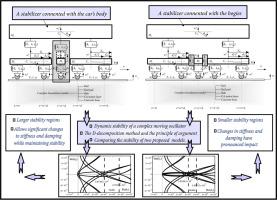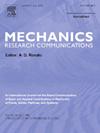Stability analysis of vibrations in a complex moving object equipped with two innovative types of stabilizers: A comparative study
IF 2.3
4区 工程技术
Q3 MECHANICS
引用次数: 0
Abstract
This study addresses the dynamic response of beam structures under moving loads, a critical challenge in the design of modern railway systems driven by advances in transportation technology. The focus lies on evaluating the vibrational stability of mechanical oscillators operating within continuous beam-foundation systems, which are integral to the reliable performance of high-speed trains. Using the d-decomposition method combined with the principle of argument, two stabilization models are compared: one incorporating a stabilizer directly attached to the car body and another employing stabilizer attached to the bogies. The findings underscore the advantages of the direct stabilizer connection, as models with car-body-connected stabilizers demonstrate larger stability regions. This configuration allows for substantial variations in stiffness and damping properties with negligible influence on stability dynamics. Conversely, models with bogie-connected stabilizers are more sensitive to parameter changes, particularly in heavier car bodies. By advancing the understanding of stabilization mechanisms in mechanical oscillators, this research contributes to the optimization of railway systems for modern transportation demands. The findings highlight the practical advantages of car-body-connected stabilizers, which offer superior adaptability and consistent stability, highlighting their potential for practical applications in the technical domain.

装有两种新型稳定器的复杂运动物体振动稳定性分析:比较研究
本研究解决了梁结构在移动载荷下的动力响应,这是现代铁路系统设计中一个关键的挑战,由运输技术的进步驱动。研究的重点在于评估连续梁基础系统中运行的机械振荡器的振动稳定性,这是高速列车可靠性能的组成部分。采用d分解法结合论证原理,对稳定器直接附着在车体上和稳定器附着在转向架上两种稳定器模型进行了比较。研究结果强调了直接稳定器连接的优势,因为车身连接稳定器的模型显示出更大的稳定区域。这种结构允许刚度和阻尼特性有很大的变化,对稳定性动力学的影响可以忽略不计。相反,带有转向架连接稳定器的模型对参数变化更敏感,尤其是在较重的车身上。通过对机械振荡器稳定机制的深入了解,本研究有助于铁路系统优化以满足现代运输需求。研究结果突出了车身连接稳定器的实际优势,它具有优越的适应性和稳定的稳定性,突出了其在技术领域的实际应用潜力。
本文章由计算机程序翻译,如有差异,请以英文原文为准。
求助全文
约1分钟内获得全文
求助全文
来源期刊
CiteScore
4.10
自引率
4.20%
发文量
114
审稿时长
9 months
期刊介绍:
Mechanics Research Communications publishes, as rapidly as possible, peer-reviewed manuscripts of high standards but restricted length. It aims to provide:
• a fast means of communication
• an exchange of ideas among workers in mechanics
• an effective method of bringing new results quickly to the public
• an informal vehicle for the discussion
• of ideas that may still be in the formative stages
The field of Mechanics will be understood to encompass the behavior of continua, fluids, solids, particles and their mixtures. Submissions must contain a strong, novel contribution to the field of mechanics, and ideally should be focused on current issues in the field involving theoretical, experimental and/or applied research, preferably within the broad expertise encompassed by the Board of Associate Editors. Deviations from these areas should be discussed in advance with the Editor-in-Chief.

 求助内容:
求助内容: 应助结果提醒方式:
应助结果提醒方式:


